Updates & Blog
A Day in the Life | FIA Forester in Florida
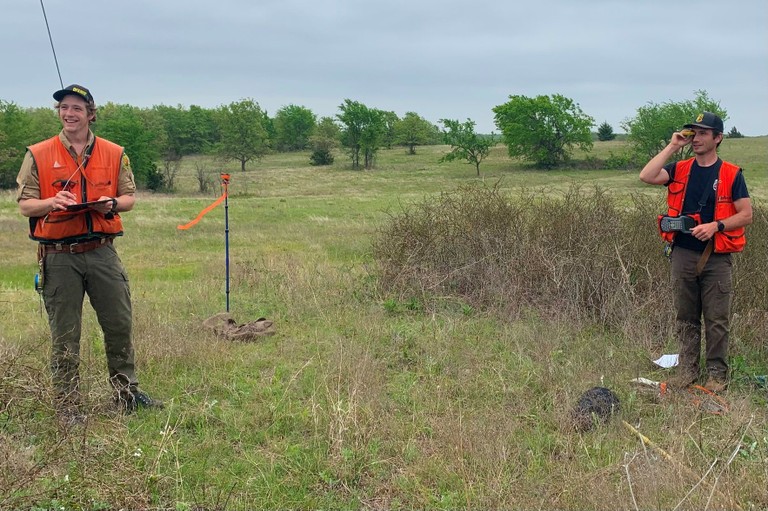
The Forest Inventory and Analysis (FIA) program provides long-term, detailed nationwide forest information. The information is used for a multitude of scientific research and is used daily by forestry agency managers, private companies and lawmakers to make crucial decisions. As information about forest change, climate change and carbon sequestration becomes increasingly important, FIA data will become even more vital on national, state and local scales – and it all begins with (and depends on) FIA foresters.
A day in the life of an FIA forester is rarely the same from one day to the next. The FIA forester works in every type of forest and is exposed to a wide variety of plant and animal species, land ownerships and diverse ecosystems. FIA foresters collect forest inventory data, such as forest type, tree species, tree size and timber quality (to name a few), on permanent survey locations called plots. They collect the same set of forest attributes for every plot and follow a detailed and expansive list of protocols. This requires a high degree of knowledge, taking most FIA foresters at least a year to become proficient in data collection.
This type of work environment is perfect for the new forester as it allows them to gain valuable experience and provides the groundwork for a rewarding career path. FIA work may not be considered glamorous (sometimes it is hot, buggy and requires long walks) but for those looking for challenge and adventure, this job is perfect. This is a look into my “atypical” day as an FIA forester in Florida.

7:00 – 7:30 a.m. | Workday Begins
At the start of my workday, crew members meet to develop or confirm a plan for the day ahead. Usually, the plan for a specific day has already been determined, but we always remain flexible to adapt to changing situations. Planning FIA plot work can be complicated, and we consider many variables when selecting a crew’s work location. Examples include weather, landowner permission, access, forest type, water depth and time of year. Some plots may be best completed during drier times of the year, such as those in swamps. Others that may involve long hikes or have thick brush are better completed during cooler weather (which can be a rarity in Florida!). In the summer, crews may start earlier to escape the hottest part of the day when the risk of heat exhaustion is highest. Much of the time, access is dependent on a landowner’s availability, so FIA foresters must complete their work on the landowner’s schedule. Depending on plot difficulty, there may be single or multiple plots planned for the day. Some plots, that are more difficult to access or have a higher number of trees to measure, may take the entire day to complete. Others that have fewer trees or are easy to access may only take a few hours to complete, allowing the crew to complete another plot within the same day. If for any reason the original plan does not work out, we always have a contingency plan with a backup plot identified. Ease of access is also a determining factor when coming up with our contingency plan.
7:30 – 8:00 a.m. | Travel Time!
Some plots are close, some are far. Some plots are easily accessed off of main roads and some require navigating a labyrinth of forest roads. Crews may be stopped by a washout in the road or a downed tree. Sometimes a road the crew is traveling becomes too muddy and wet to cross and they need to find another route. Frequently, crews must wait for drier weather when roads become passable again. When these challenges come our way, the crew will go with the backup plan. For this example, though, we’ll say it takes half an hour to get to the plot.
Many plots each year in Florida must be accessed by boat.
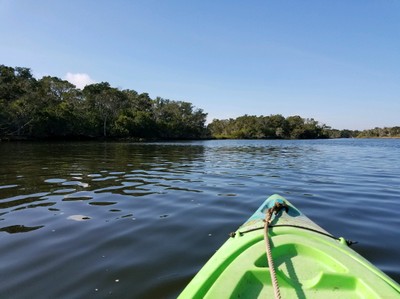
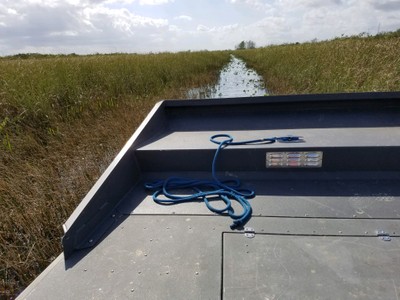
Photos by Florida Forest Service.
8:00 – 8:30 a.m. | Identify the Starting Point
Each plot has a predetermined starting point. The starting point is determined by a previous crew and is something easily identifiable on the ground, such as a utility pole, road intersection or unique tree. Something that the next crew can easily find and will help them get to the plot location. Each starting point comes with a distance and azimuth to the plot location, recorded by the previous crew and passed on to the current crew. The current crew also records this information for the next crew. If a starting point is no longer there, or there is a better one, the current crew will change the starting point and record the new information.
8:30 – 9:00 a.m. | Find the Plot
Once the starting point is found, it is time for the crew to get their gear in order and navigate to the plot on foot. Typically, navigation involves using a GPS. The coordinates to the plot center are provided to the crew. If navigation by GPS is unavailable, the crew can measure from the starting point using the information provided by the previous crew.
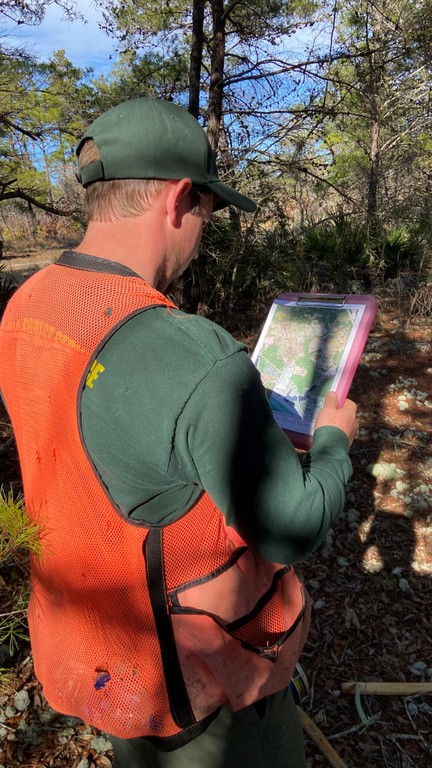
9:00 a.m. – 12:00 p.m. | Collect the Data
After the crew navigates to the plot location, it is time to find the plot center and collect the forest data. Each plot is located using two witness trees. The species, diameter, azimuth and distance of these trees were recorded by the previous crew and given to the current crew. There is also an aluminum tag on each tree for further identification. Using the azimuth and distance provided for each tree, the crew can then triangulate the plot center position. At the center of the plot, there is a small metal pin in the ground; the pin is typically found using a small metal detector once the forester gets close. Sometimes the witness trees are no longer there. This can sometimes make finding the plot center interesting. In such instances, the crew may need to line up stumps or search the area using a metal detector. Once the plot center is found, the first thing we do is record new information on the witness trees. If the same trees are used, we simply record a new diameter and keep all the other old information if still accurate. If the witness trees are gone, new witness trees or landmarks must be recorded.
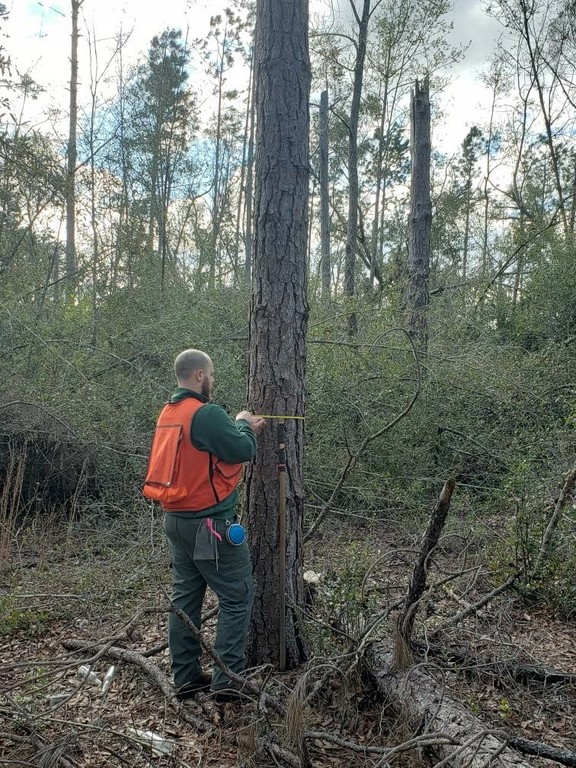
Once the location of the witness trees has been recorded, it is time to collect the forest inventory data. An FIA plot is a set of eight fixed-area plots: four larger ones (subplots) and four small ones (micro plots). The larger subplots are used to collect data on larger trees, and the smaller micro plots are used to collect data on seedlings and saplings. Previous tree data is provided to the crews to aid in making sure the same trees are measured consistently, new or mortality trees are accounted for, and forest change is accurately recorded. Data collected on an FIA plot includes, but is not limited to:
- Tree species
- Timber merchantability and quality
- Tree health
- Tree diameter and length
- Forest type
- Forest disturbance
- Land ownership
- Water depth
- Slope and aspect
- Harvest information
- Silvicultural activity
- Down woody debris
- Site index
- Non-native invasive plant occurence
- Forest regeneration
The length of time it takes to complete an FIA plot is highly variable. For this example, however, we’ll say this plot is not overly challenging, everything was easy to find and there were not many trees to measure – a typical longleaf pine forest type, perhaps.
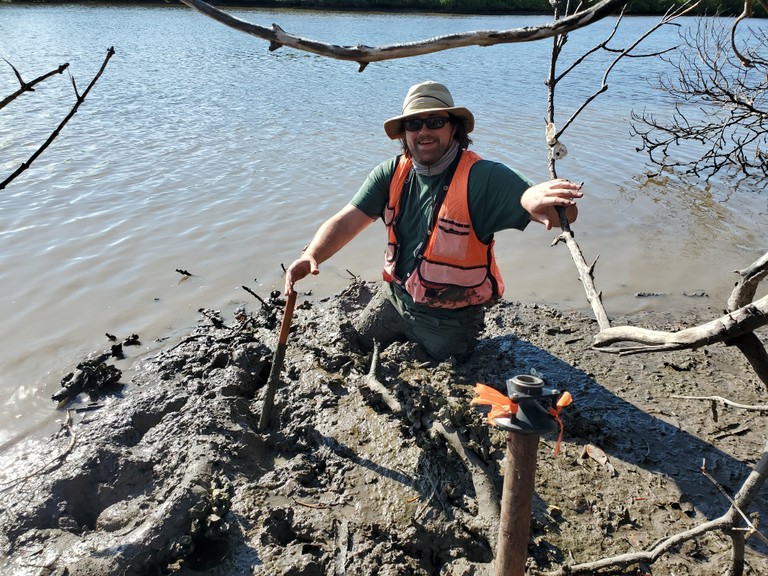
12:00 – 1:00 p.m. | Planning our Afternoon
The crew returns to the truck, puts their gear away and enjoys a packed lunch in the field. They also come up with a plan to access another plot location. In this example, we’ll say there is another plot approximately half an hour away and can be completed in an afternoon. This may not always be the case as there may not be another nearby plot available, or permission may not be lined up to access another plot, or there there are no available plots that can be completed quickly. If this is the case, crews may use their afternoon to contact landowners to set something up for the next day, or start a plot and finish it the next morning.
1:00 – 1:30 p.m. | Travel to the Other Plot Location
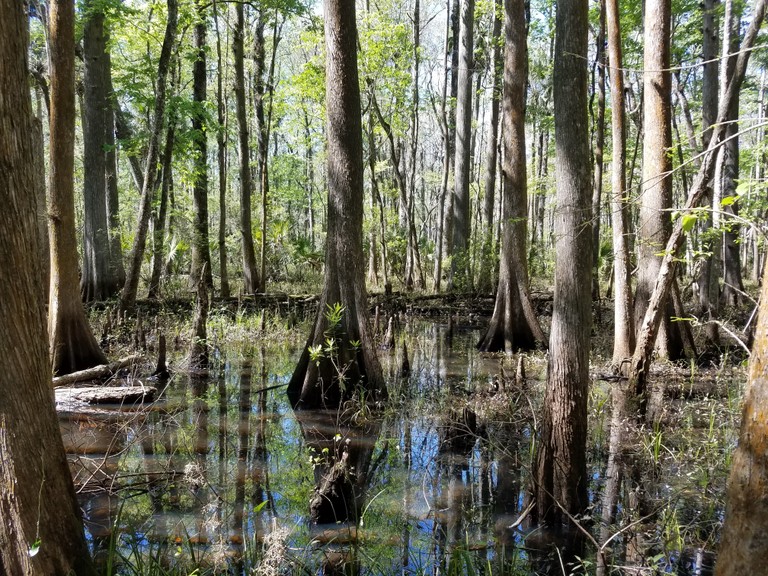
1:30 – 4:00 p.m. | Repeat Plot Data Collection Process
Start the whole process over again, identify the starting point, navigate to the plot, find the plot center pins, collect the forest inventory data.
4:00 – 4:45 p.m. | Back to the Office
Walk to the truck, put the gear away and drive back to the office.
4:45 – 5:00 p.m. | Submit Data and End Workday
Plot data was collected in the woods using an electronic data recorder. We’ll now remove the plot data from the data recorder and transmit via computer to the USDA Forest Service through a USDA Forest Service digital application.
Discuss the next day’s plan with the other crew members. Rest up tonight because it all starts over again tomorrow!